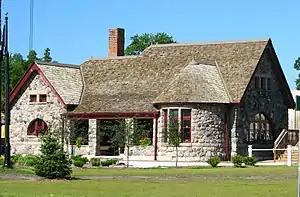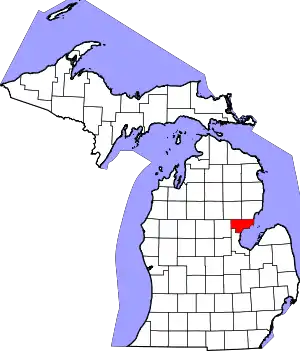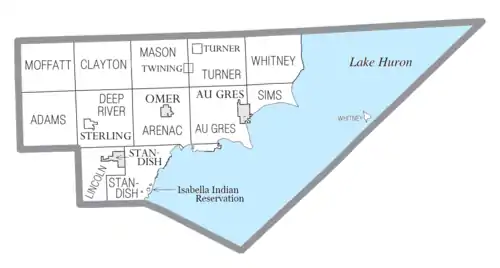Arenac County, Michigan
Arenac County is a county located in the U.S. state of Michigan. As of the 2010 census, the population was 15,899.[2] The county seat is Standish.[3]
Arenac County | |
|---|---|
 Michigan Central Railroad Standish Depot | |
 Location within the U.S. state of Michigan | |
 Michigan's location within the U.S. | |
| Coordinates: 44°03′N 83°45′W | |
| Country | |
| State | |
| Founded | 1883[1] |
| Seat | Standish |
| Largest city | Standish |
| Area | |
| • Total | 681 sq mi (1,760 km2) |
| • Land | 363 sq mi (940 km2) |
| • Water | 317 sq mi (820 km2) 47%% |
| Population | |
| • Estimate (2018) | 15,041 |
| • Density | 44/sq mi (17/km2) |
| Time zone | UTC−5 (Eastern) |
| • Summer (DST) | UTC−4 (EDT) |
| Congressional district | 5th |
History
Arenac County was organized in 1883. The name Arenac, coined by Henry Rowe Schoolcraft, US Indian Agent and ethnologist, is a derivation of the Latin arena and the Native American ac. The combined words mean “A sandy place for a good footing.”[1][4]
The county includes some off-reservation trust lands held by the federal government for the federally recognized Saginaw Chippewa Tribal Nation, which is based in Isabella County. In early 2007, plans were confirmed for a casino to be constructed outside of the city of Standish with a scheduled opening by the end of the year. It is owned and operated by the Saginaw Chippewa Tribe.[5] The Saganing Eagles Landing Casino grand opening was held on January 24, 2008.[6]
Geography
According to the U.S. Census Bureau, the county has a total area of 681 square miles (1,760 km2), of which 363 square miles (940 km2) is land and 317 square miles (820 km2) (47%) is water.[7] It is the third-smallest county in Michigan by land area. Arenac County can be considered a part of either Northern Michigan or Central Michigan.
Geographic features
- Saginaw Bay on Lake Huron
- Au Gres River
- Rifle River
- Pine River (Arenac County)
Adjacent counties
- Iosco County - northeast
- Bay County - south
- Gladwin County - west
- Ogemaw County - northwest
National protected area
Demographics
| Historical population | |||
|---|---|---|---|
| Census | Pop. | %± | |
| 1890 | 5,683 | — | |
| 1900 | 9,821 | 72.8% | |
| 1910 | 9,640 | −1.8% | |
| 1920 | 9,460 | −1.9% | |
| 1930 | 8,007 | −15.4% | |
| 1940 | 9,233 | 15.3% | |
| 1950 | 9,644 | 4.5% | |
| 1960 | 9,860 | 2.2% | |
| 1970 | 11,149 | 13.1% | |
| 1980 | 14,706 | 31.9% | |
| 1990 | 14,931 | 1.5% | |
| 2000 | 17,269 | 15.7% | |
| 2010 | 15,899 | −7.9% | |
| 2018 (est.) | 15,041 | [8] | −5.4% |
| US Decennial Census[9] 1790-1960[10] 1900-1990[11] 1990-2000[12] 2010-2018[2] | |||
As of the 2000 United States Census,[13] there were 17,269 people, 6,710 households, and 4,717 families in the county. The population density was 47 people per square mile (18/km2). There were 9,563 housing units at an average density of 26 per square mile (10/km2). The racial makeup of the county was 95.38% White, 1.82% Black or African American, 0.95% Native American, 0.29% Asian, 0.01% Pacific Islander, 0.21% from other races, and 1.33% from two or more races. 1.38% of the population were Hispanic or Latino of any race. 24.0% were of German, 14.1% Polish, 11.6% French, 10.6% American, 7.9% English, 6.8% Irish and 5.3% French Canadian ancestry. 96.9% spoke English and 1.3% Spanish as their first language.
There were 6,710 households, out of which 29.00% had children under the age of 18 living with them, 57.00% were married couples living together, 9.00% had a female householder with no husband present, and 29.70% were non-families. 25.50% of all households were made up of individuals, and 12.30% had someone living alone who was 65 years of age or older. The average household size was 2.45 and the average family size was 2.92.
The county population contained 23.30% under the age of 18, 7.80% from 18 to 24, 26.80% from 25 to 44, 25.50% from 45 to 64, and 16.60% who were 65 years of age or older. The median age was 40 years. For every 100 females there were 105.40 males. For every 100 females age 18 and over, there were 104.40 males.
The median income for a household in the county was $32,805, and the median income for a family was $39,033. Males had a median income of $31,205 versus $20,363 for females. The per capita income for the county was $16,300. About 11.30% of families and 13.90% of the population were below the poverty line, including 20.70% of those under age 18 and 7.80% of those age 65 or over.
Religion
- The Roman Catholic Diocese of Saginaw is the controlling regional body for the Catholic Church.[14]
- There are no meetinghouses of The Church of Jesus Christ of Latter-day Saints located within Arenac County.[15]
Government
Arenac County could be described as slightly Republican-leaning. Since 1884, the Republican Party nominee has carried the county vote in 53% of the elections (18 of 34 elections). Due to 3 elections won by independent candidates during that period, the Democratic record is only 38% (13 of 34).
| Year | Republican | Democratic | Third Parties |
|---|---|---|---|
| 2020 | 67.1% 5,928 | 31.4% 2,774 | 1.5% 137 |
| 2016 | 64.0% 4,950 | 30.8% 2,384 | 5.1% 395 |
| 2012 | 51.7% 4,057 | 46.8% 3,669 | 1.5% 115 |
| 2008 | 46.8% 3,807 | 51.1% 4,155 | 2.0% 166 |
| 2004 | 49.6% 4,071 | 49.6% 4,076 | 0.8% 69 |
| 2000 | 47.1% 3,421 | 50.7% 3,685 | 2.2% 161 |
| 1996 | 34.1% 2,247 | 52.7% 3,472 | 13.2% 872 |
| 1992 | 32.3% 2,330 | 45.0% 3,244 | 22.6% 1,632 |
| 1988 | 48.6% 3,064 | 51.0% 3,211 | 0.4% 25 |
| 1984 | 58.6% 3,483 | 41.0% 2,436 | 0.4% 22 |
| 1980 | 53.4% 3,436 | 39.6% 2,547 | 7.0% 448 |
| 1976 | 49.6% 2,687 | 49.7% 2,695 | 0.8% 41 |
| 1972 | 57.4% 2,588 | 40.6% 1,829 | 2.0% 89 |
| 1968 | 52.4% 2,089 | 39.4% 1,573 | 8.2% 327 |
| 1964 | 36.7% 1,413 | 63.2% 2,436 | 0.1% 3 |
| 1960 | 55.3% 2,352 | 44.4% 1,888 | 0.2% 10 |
| 1956 | 63.3% 2,631 | 36.6% 1,520 | 0.1% 4 |
| 1952 | 67.7% 2,753 | 31.7% 1,290 | 0.5% 21 |
| 1948 | 58.9% 1,790 | 39.6% 1,203 | 1.6% 48 |
| 1944 | 60.5% 1,978 | 39.1% 1,280 | 0.4% 13 |
| 1940 | 60.2% 2,293 | 39.4% 1,499 | 0.4% 15 |
| 1936 | 43.5% 1,505 | 50.9% 1,761 | 5.6% 194 |
| 1932 | 40.1% 1,471 | 56.9% 2,086 | 3.0% 109 |
| 1928 | 67.9% 1,612 | 31.5% 749 | 0.6% 14 |
| 1924 | 67.6% 1,767 | 22.0% 575 | 10.4% 273 |
| 1920 | 66.4% 1,521 | 29.2% 669 | 4.5% 102 |
| 1916 | 46.9% 911 | 48.3% 938 | 4.9% 95 |
| 1912 | 21.2% 421 | 22.7% 452 | 56.1% 1,116 |
| 1908 | 56.2% 1,081 | 37.1% 714 | 6.7% 129 |
| 1904 | 68.8% 1,372 | 23.0% 458 | 8.3% 165 |
| 1900 | 51.0% 972 | 45.2% 861 | 3.8% 72 |
| 1896 | 37.4% 611 | 61.0% 997 | 1.6% 26 |
| 1892 | 27.8% 322 | 32.2% 373 | 40.0% 463 |
| 1888 | 31.9% 357 | 23.3% 261 | 44.9% 503 |
| 1884 | 32.0% 323 | 60.0% 607 | 8.0% 81 |
The county government operates the jail, maintains rural roads, operates the major local courts, records deeds, mortgages, and vital records, administers public health regulations, and participates with the state in the provision of social services. The county board of commissioners controls the budget and has limited authority to make laws or ordinances. In Michigan, most local government functions — police and fire, building and zoning, tax assessment, street maintenance, etc. — are the responsibility of individual cities and townships.
Elected officials
- Prosecuting Attorney: Curtis Broughton
- Sheriff: Jim Mosciski
- County Clerk: Ricky R. Rockwell
- County Treasurer: Dennis Stawowy
- Register of Deeds: Darlene Mikkola
- Drain Commissioner: Jeff Trombley
- Road Commissioners: Blair Dyer-Superintendent; Ken Stawowy-V. Chair; Lewis Ostrander; Olen Swartz-Chair
(information as of March 2009)
Communities

Civil townships
Unincorporated communities
Indian reservation
- Arenac County contains off-reservation trust land belonging to the Isabella Indian Reservation. They occupy three small parcels of land located within Standish Township.
Events
- Sunrise Side Heritage Bike Ride, first weekend in September. Ride Along Lake Huron Shoreline (US 23) from the Arenac County fairgrounds to Mackinac Bridge then South to West Branch on M-33 and M-55 . This is a 400-mile long organized ride.[17]
See also
References
- "Bibliography on Arenac County". Clarke Historical Library, Central Michigan University. Retrieved January 19, 2013.
- "State & County QuickFacts". US Census Bureau. Archived from the original on July 6, 2011. Retrieved August 26, 2013.
- "Find a County". National Association of Counties. Archived from the original on May 31, 2011. Retrieved June 7, 2011.
- "Arenac County Michigan History Information". outdoor-michigan.com. Archived from the original on June 22, 2010.
- "Michigan Ann Arbor Bay City Detroit Flint Grand Rapids Jackson Kalamazoo Lansing Muskegon Saginaw All Michigan". mlive.com.
- "Saganing Eagles Landing grand opening" Archived April 10, 2008, at the Wayback Machine, casino website
- "2010 Census Gazetteer Files". US Census Bureau. August 22, 2012. Archived from the original on November 13, 2013. Retrieved September 18, 2014.
- "Population and Housing Unit Estimates". Retrieved May 18, 2019.
- "US Decennial Census". US Census Bureau. Archived from the original on April 26, 2015. Retrieved September 18, 2014.
- "Historical Census Browser". University of Virginia Library. Retrieved September 18, 2014.
- "Population of Counties by Decennial Census: 1900 to 1990". US Census Bureau. Retrieved September 18, 2014.
- "Census 2000 PHC-T-4. Ranking Tables for Counties: 1990 and 2000" (PDF). US Census Bureau. Retrieved September 18, 2014.
- Statistical profile of Arenac County, Michigan Archived April 10, 2008, at the Wayback Machine
- "Diocese of Saginaw". saginaw.org.
- LDS.ord Meetinghouse Locator (accessed 3 September 2018)
- US Election Atlas
- "Sunrise side bike ride" (PDF). Archived from the original (PDF) on February 11, 2012. Retrieved April 24, 2008.
Further reading
- Romig, Walter (1986) [1973]. Michigan Place Names: The History of the Founding and the Naming of More than Five Thousand Past and Present Michigan Communities. Great Lakes Books. Detroit: Wayne State University Press. ISBN 978-0814318386.
External links
- The Arenac County Independent
- Arenac County government
- "Bibliography on Arenac County". Clarke Historical Library, Central Michigan University.
